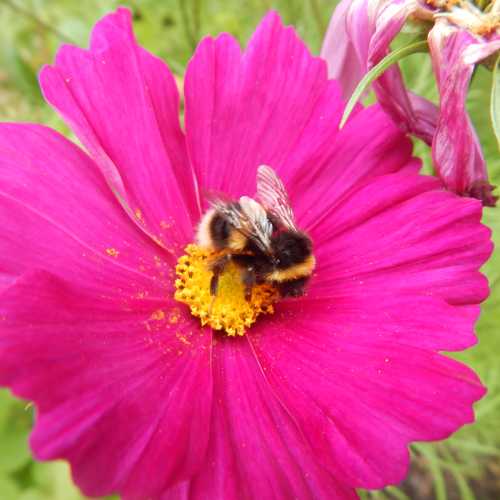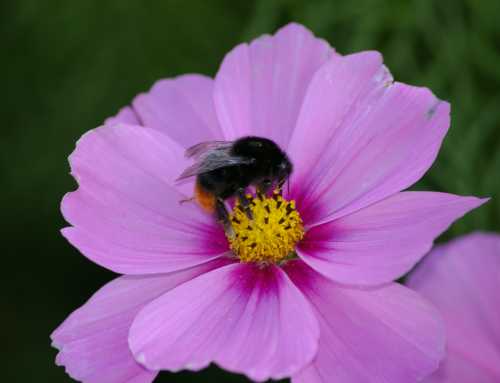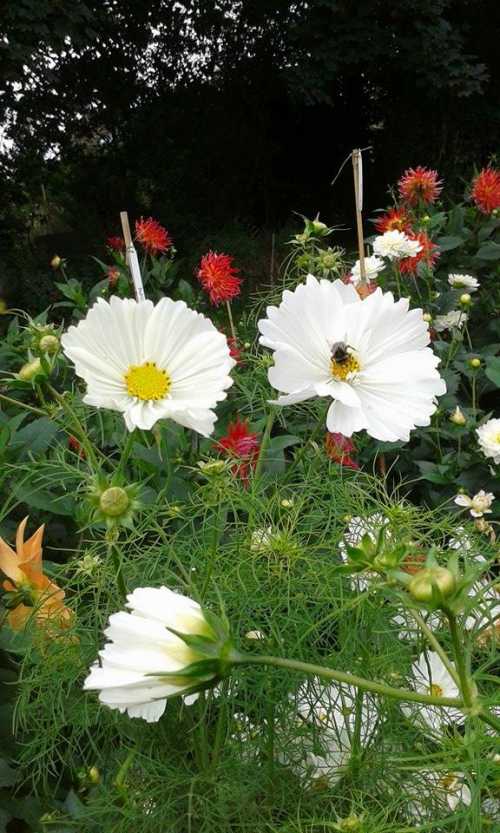Why Cosmos bipinnatus (Mexican Aster) Is Perfect For the Bee Garden
Cosmos bipinnatus, also commonly known simply as 'Cosmos', Garden Cosmos, or Mexican Aster is a stunning flower that will not only provide you with cheerful blooms, it will attract bees too.
In fact, there's a very good reason why anyone who is serious about helping bees by creating a bee garden will want to include this fabulous flower, and the reason is that scientific data has revealed that Cosmos offers bees a good quantity of nectar and pollen, whilst being relatively long flowering - more about that below.
Cosmos bipinnatus - a feast for the bees, and a feast for human eyes
Many flowers are valuable for bees because they offer a rich source of quality pollen or nectar. Seasonal factors, along with issues such as pollinator constancy are also relevant (i.e. the tendency of individual pollinators to visit only certain flower species).

Nevertheless, some flowers provide both nectar and pollen.
Nectar is an energy food for bees, providing important carbohydrate in the form of sugars.
Pollen on the other hand, is vital for its lipid and protein content, and the individual nutrients provided by the various protein amino acids.
How much nectar and pollen do Cosmos provide for bees?
In 2016, Hicks et al published a paper: Quantify the Nectar and Pollen Resources of Urban Flower Meadows1. A number of flowers were included in the study, and categorized:
- flowers from a commercial annual flower mix,
- a '“Special Pollen and Nectar Wildflower” mix,
- and another group that comprised 'weed' species.
For the purposes of this page, I'm only going to refer to the annual seed mix, since the range comprised plants that are considered 'garden flowers'.

Below are two tables in which I have compiled all the mean (average) amounts of pollen and nectar for the 12 flowers from the study.
Whilst 12 is only a small number, nevertheless, the individual data values are given, and anecdotal evidence (observation on my part) would suggest that Cosmos is a valuable and very attractive flower for bees.
Pollen Offering
From the table below, it is interesting to note the following:
- Cosmos comes fourth on the list for mean volume of pollen per flower per day, behind both poppies (also loved by bees).
- However, Cosmos has a longer flowering period than either of the poppies, thus providing an extended foraging period for bees.
| Common name | Scientific name | Mean volume of pollen (µl/day)* | Floral unit longevity (days) |
|---|---|---|---|
| Common poppy | Papaver rhoeas | 5.958 | 2.239 |
| Californian Poppy | Eschscholzia californica | 2.407 | 3.440 |
| Pot Marigold | Calendula officinalis | 1.814 | 6.706 |
| Cosmos | Cosmos bipinnatus | 1.692 | 8.154 |
| Red Flax | Linum grandiflorum | 0.707 | 1.864 |
| Love-in-a-mist | Nigella damascena | 0.549 | 5.789 |
| Cornflower | Centaurea cyanus | 0.547 | 6.467 |
| Golden Tickseed | Coreopsis tinctoria | 0.455 | 5.067 |
| Showy Baby’s breath | Gypsophila elegans | 0.072 | 2.357 |
| Virginia Stock | Malcolmia maritima | 0.057 | 4.280 |
| Tickseed | Coreopsis picta | 0.055 | 13.200 |
| Sweet Alyssum | Lobularia maritima | 0.006 | 2.631 |
*Mean volume of pollen per flower or capitulum per day (µl/day)
Nectar Offering
For nectar, what we can see is that Cosmos jumps to second place in the rankings (the poppies are ranked lower for nectar, although I still recommend them for their excellent pollen content).
| Common name | Scientific name | Mean mass of nectar sugar per flower (µg/day)* | Floral unit longevity (days) |
|---|---|---|---|
| Cornflower | Centaurea cyanus | 895.831 | 6.467 |
| Cosmos | Cosmos bipinnatus | 701.078 | 8.154 |
| Pot Marigold | Calendula officinalis | 469.515 | 6.706 |
| Showy Baby’s breath | Gypsophila elegans | 369.234 | 2.357 |
| Tickseed | Coreopsis picta | 277.902 | 13.200 |
| Love-in-a-mist | Nigella damascena | 240.301 | 5.789 |
| Golden Tickseed | Coreopsis tinctoria | 133.471 | 5.067 |
| Red Flax | Linum grandiflorum | 50.214 | 1.864 |
| Virginia Stock | Malcolmia maritima | 46.349 | 4.280 |
| Californian Poppy | Eschscholzia californica | 10.317 | 3.440 |
| Sweet Alyssum | Lobularia maritima | 4.213 | 2.631 |
| Common poppy | Papaver rhoeas | 0.570 | 2.239 |
*Mean mass of nectar sugar per single flower or capitulum (µg/day)
From the evidence of both tables combined, not to mention personal observation, I absolutely recommend Cosmos bipinnatus for inclusion in pollinator gardens.

Planting Cosmos bipinnatus for bees
I've had pinks and white Cosmos in my garden at various times. Currently, the space that was previously occupied by Cosmos is at the moment occupied by oxeye daisies, another beneficial flower.
However, having seen the data, it looks like I'm going to have to find a spot and squeeze Cosmos into my garden again.
To grow Cosmos, sow the seeds under glass in mid spring, or you can sow them directly in the soil where they are to flower. Select a sunny spot. Deadhead to prolong the flowering season.
These plants are fairly tall (around 1 to 1.5 meters high) and quite bushy with feathery foliage, so ensure they have a good amount of space.
Which bees like Cosmos flowers?
Although the photographs on this page feature bumble bees, Cosmos are also loved by honey bees and a range of solitary bee species.

References
1. Hicks DM, Ouvrard P, Baldock KCR, Baude M, Goddard MA, Kunin WE, et al. (2016) Food for Pollinators: Quantifying the Nectar and Pollen Resources of Urban Flower Meadows. PLoS ONE 11(6): e0158117.
More articles about bees and plants
- Bees And Brambles: The Value Of Brambles To Bees Also known as blackberry bush, research shows each bramble flower secretes lots of nectar for bees!
- Bees And Bee Balm Bee Balm (Monarda) - also known as 'Bergamot) is a herbaceous perennial which is attractive for bees.
- 30 Fantastic Garden Flowers For Bees Flowering plant recommendations for the perfect bee garden.
- Bees love lupins – but so do slugs and snails, so what can you do? Here's a way to protect your lupins....using garlic!
- Plant Oregano For Bees (Marjoram) It's rich in nectar, and attracts bees, butterflies and hoverflies in summer. Here's how to plant it.
- Fennel Pollen And Nectar Bees love fennel! How to grow it, gather it, and the many uses of fennel seeds and pollen.
If you found this page helpful or interesting, I'd really be grateful if you would share it with others - if not this page, perhaps another, such as Gardening For Bees.
Thank you so much :) .